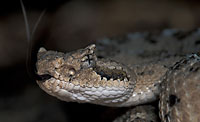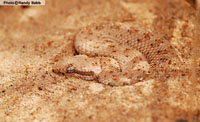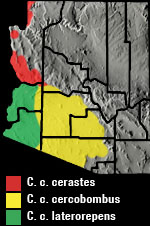Online Field Guide to The Reptiles and Amphibians of Arizona


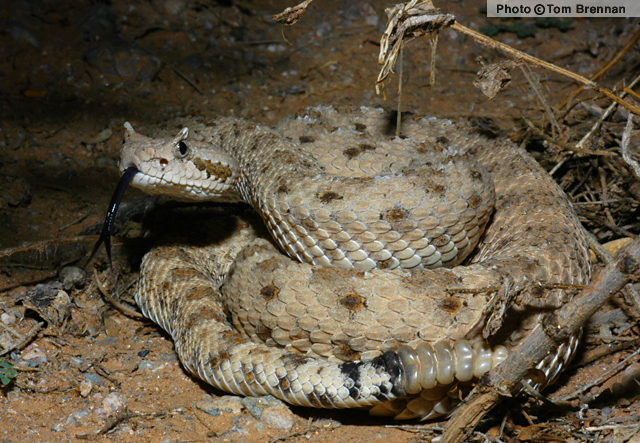
Maricopa County, Arizona
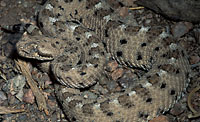 Maricopa Co., AZ |
||
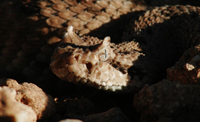 Maricopa Co., AZ |
| SIDEWINDER Crotalus cerastes |
Venomous
|
| DESCRIPTION: A small (up to 628 mm or 25″ in total length excluding rattle), tan, pinkish-tan, cream, or light gray colored rattlesnake with brown or gray-brown dorsal blotches. Chalky-white coloration marks the dorsum between the blotches. A dark stripe extends back from the eye to above the corner of the mouth. Black rings mark the tip of the tail. The general coloration often matches the soil or sand on which the snake lives. A thin, dark, horizontal line crosses the center of the eye. The pupils are vertically elliptical. The scales above the eyes (supraoculars) are enlarged, upturned, pointed, and horn-like. The dorsal scales are keeled. The neck is slender and the head is broad and triangular. On the end of the tail is a rattle composed of a series of loosely interlocking keratinous sections. A new section is added each time the snake sheds its skin.
DISTRIBUTION: This snake is distributed across the low deserts of western and southwestern Arizona at elevations ranging from near sea level along the colorado River to about 2,800′. HABITAT: Chiefly and inhabitant of Mohave Desertscrub and Lower Colorado River Valley Sonoran Desertscrub, but it also enters relatively level terrain in the lower reaches of Arizona Upland Sonoran Desertscrub. It can be a common sight in open, flat, creosotebush-grown desert with sandy or loamy soil. It is also common in the dune fields of southwestern and western Arizona.BEHAVIOR: Nocturnal and crepuscular during the hot summer months, it shelters in underground burrows during the day. It is diurnal and crepuscular during spring when it is often encountered coiled on the surface in the partial shade of a creosotebush. In sandy areas this snake often coils partially buried in the sand, sometimes with only the head and dorsum exposed. This ground-dweller’s distinctive method of locomotion (side-winding) involves the snake moving sideways with its body winding through an “S” shaped curve. While side-winding only a few points of the snakes body contact the hot sand at any one time. This method of locomotion leaves distinctive parallel J-shaped tracks with the hooks of the “J”s pointing in the direction of travel. Like the other “pit-vipers” (members of the subfamily Crotalinae) this snake uses heat sensing pits (one on each side of the face between the eye and nostril) to detect warm-blooded predators and prey. DIET: The Sidewinder is an ambush hunter that coils and waits for unsuspecting lizards, mice, birds, and snakes to wander within striking distance. It uses venom injected through long, hollow, retractable fangs to kill and begin digesting its prey.REPRODUCTION: Mating takes place in spring and a litter of up to 20 young is born in July or August. SUBSPECIES FOUND IN AZ: SONORAN SIDEWINDER Crotalus cerastes cercobombus. This subspecies usually has 21 dorsal scale rows and a black proximal rattle segment (segment nearest tail). COLORADO DESERT SIDEWINDER Crotalus cerastes laterorepens This subspecies usually has 23 dorsal scale rows and a black proximal rattle segment (segment nearest tail). REMARKS: This rattlesnake is capable of delivering potent venom. If encountered it should be left alone. A large percentage of envenomations occur when a snake is handled or abused. By Thomas C. Brennan Bartlett. 2000. Snakes of North America: Western Gulf Publishing Co. Houston, TX Brennan, T. C., and A. T. Holycross. 2006. A Field Guide to Amphibians and Reptiles in Arizona. Arizona Game and Fish Department. Phoenix, AZ Brennan, T. C., and A. T. Holycross. 2005. A Field Guide to Amphibians and Reptiles of Maricopa County. Arizona Game and Fish Department. Phoenix, AZ Fowlie. 1965. The Snakes of Arizona. Azul Quinta Press, Fallbrook, California Lowe, Schwalbe, Johnson. 1986. The Venomous Reptiles of Arizona. Nongame Branch Stebbins. 1985. Western Reptiles and Amphibians. Houghton Mifflin. New York, |
|
Visit Partners in Amphibian and Reptile Conservation:


HOME
Copyright © 2023, Arizona Game and Fish Department. All rights reserved.
If you make use of the textual contents of this site in reports, publications, etc. please cite and credit the author(s) and photographer(s). All photos on this website are copyrighted. However, those found in the species account section may be used for any noncommercial scientific, educational, or conservation purposes provided that photographs are not altered and continue to bear the copyright symbol and name of the photographer. Please contact the photographer regarding commercial use of copyrighted photographs.










